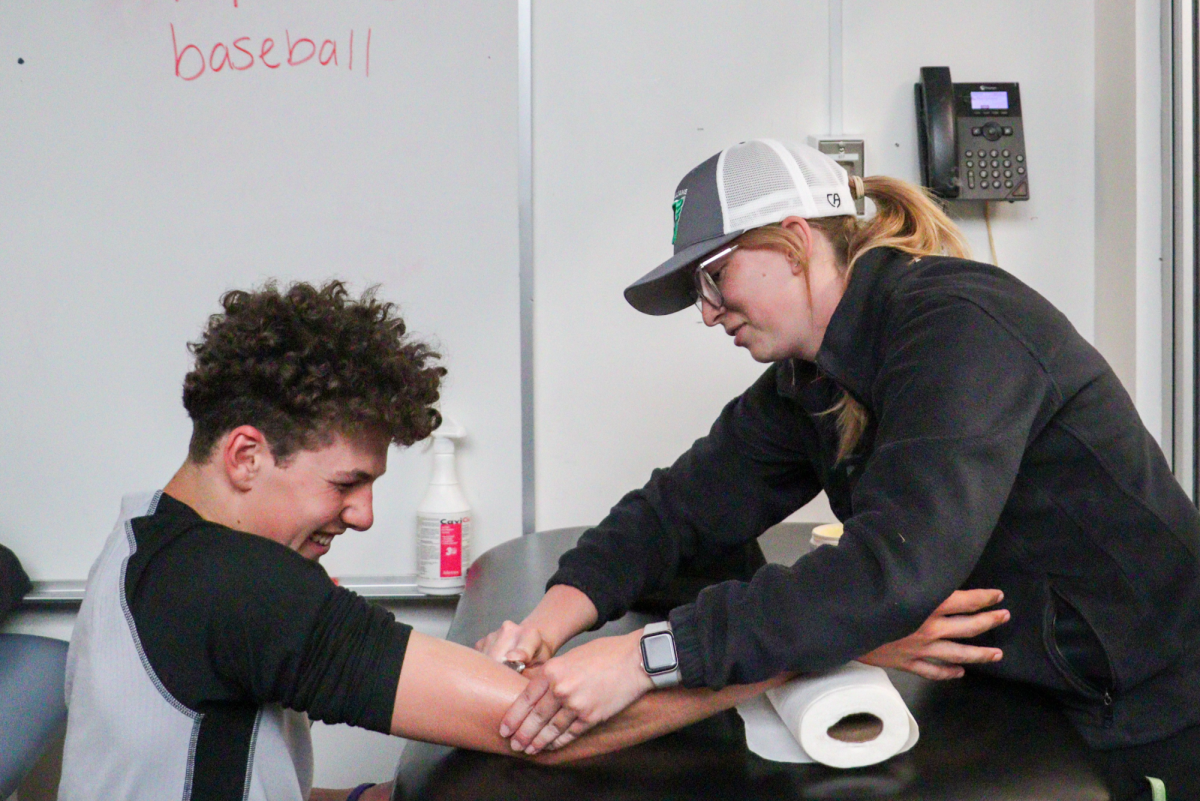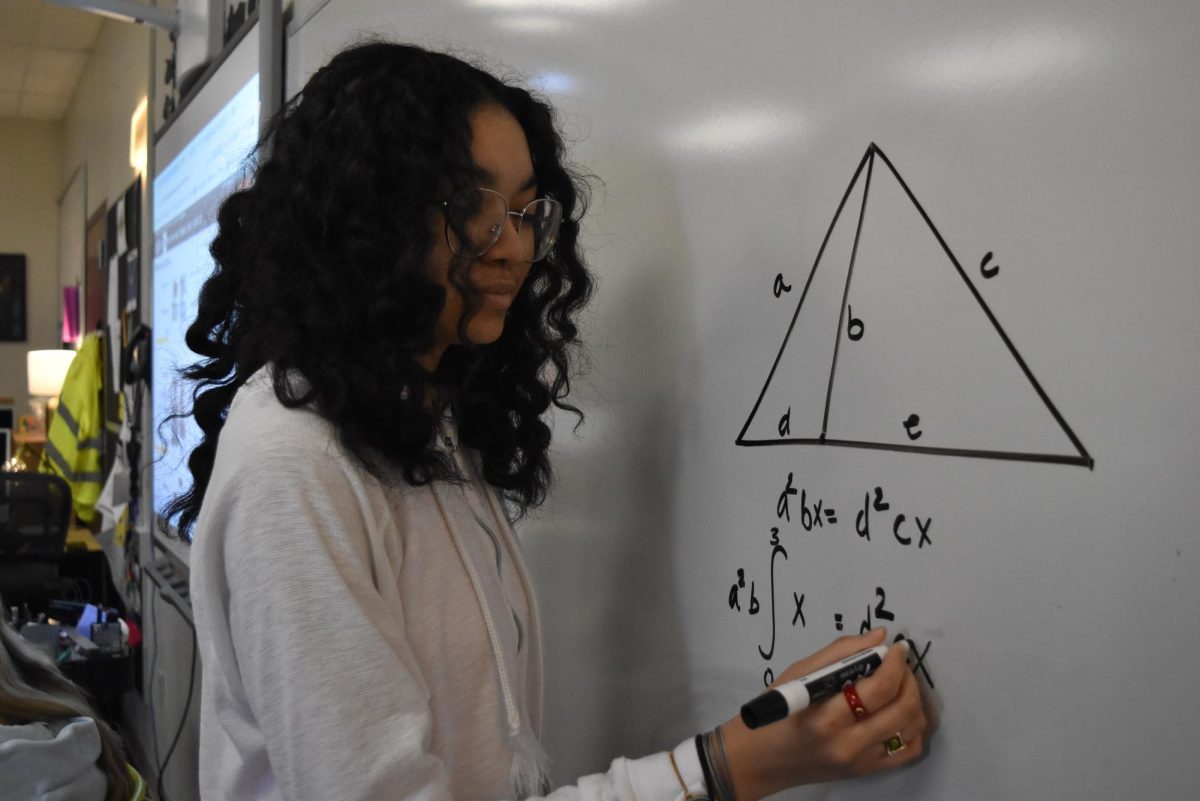Thirty thousand students in the United States participate annually in the American Mathematics Competition, an exam that allows students to potentially represent the U.S. in the International Math Olympiad. Yet, only 14% of those students identify as girls, and a smaller proportion make it to the top ranks.
While at first glance, this may appear to be solely a participation issue, the lack of girls pursuing competitive math, especially in school, can lead to math anxiety. This problem leads to diminishing performance and engagement in advanced and competitive math. Multiple studies have found that by third grade, many girls lose confidence in math, which leads to a gendered math gap where, in higher-income households, boys tend to score higher in math than girls, and in lower-income households, girls perform better but only by a small percentage.
“I think it’s a deep-rooted opinion in our society that women aren’t as capable in STEM fields. This is a sad reality, even given that my grandmother was one of two women who graduated with a degree in chemistry the year she graduated,” assistant math department head and Math Contest Program leader Patrick Mooney said.
One of the most common reasons why many girls tend to lose interest in math early on is because of the myth of the “math brain”: boys tend to be more logical and better fit for STEM fields, while women tend to be more emotional, better fit for the arts and humanities. Yet, research shows no innate cognitive biological differences between men and women in math. This makes sense evolutionarily 一 why should women, who often become mothers and have the responsibility of carrying the child, be less logical than their male counterparts?
Freshman Alisha Yin has been involved in science competitions, like Science Bowl and math contests, like the American Math Competition (AMC) series and MCTM since the fifth grade.
“A lot of people claim there’s ‘equal opportunity’ for women to participate in math contests or pursue STEM and that they are not doing it simply because they are not inclined. But that’s not the case at all,” Yin said. “From my experience, a lot of girls have a lot of interest in these subjects and especially in competing in STEM subjects. But, they end up not pursuing them or working as hard in them because, for young girls, there isn’t as strong of a pre-established culture around it, as young boys [have]. So, as a girl, you have to implement yourself harder to see yourself in the same dreams the boys your age have.”
As a young girl, you have to implement yourself harder to see yourself in the same dreams the boys your age have”
— Alisha Yin
“When I was younger, math was a huge part of my life, with studying for contests like Mathcounts and MathLeague taking up large portions of my time,” Yin said. “But slowly, as less and less of my friends were doing these contests with me, I lost motivation. I had friends who were guys, but it just wasn’t the same because they would obviously be closer with their other male friends.”
In addition, due to the lack of participation, there are going to be fewer performing well enough to qualify for selective math exams like the American Invitation Math Examination or International Math Olympiad, leading to less representation, which can, in turn, demotivate younger girls from participating in the preliminary stages that can lead them to such paths.
“In the whole middle school math team, with 14 people, I would be the only girl. And then when I’d go on stage, to receive awards for being top 10 or top five, I’d be the only girl up there, which was pretty alienating,” Yin said. “I remember in fifth or sixth grade I got first in the state in the Countdown round of the MathCounts competition. Afterwards, a lot of people were saying it was easier for me to get first because I was a girl, and the competition managers ‘went easier.’ But, that was literally not the case because all the questions are the same difficulty and randomly generated. It’s little comments like this that make a big difference in a girl’s motivation to not only participate in math contests but actually study and work for excelling in them.”
Ultimately, employees in the STEM field earn two-thirds more than those employed in other fields, according to the Pew Research Center. And, a direct pipeline to the highest-paying jobs in the STEM field, like quantitative traders and software engineers, is competitive math. So, the gender gap in competition math can actually lead to a lack of monetary independence in women, further perpetuating gender stereotypes.
“I think the more we encourage the analytical intelligence of women, it will decrease the gender gaps in the field. In other words, showing girls they can do STEM now will make it easier to keep them doing it in the future,” Mooney said. “We need to show the student population that it is fun to challenge ourselves every once in a while.”
Male-dominated competition in math environments leads to male-dominated industries in highly lucrative careers. But, it’s time to turn this gender gap into a bridge, where everyone works to incorporate diversity and meritocracy in a high-achieving academic environment. It’s not just about promoting participation to meet diversity quotas; it’s about promoting the idea that girls can succeed in a competitive, cutthroat environment and win.
This story was originally published on Pathfinder on January 23, 2024.
































![IN THE SPOTLIGHT: Junior Zalie Mann performs “I Love to Cry at Weddings,” an ensemble piece from the fall musical Sweet Charity, to prospective students during the Fine Arts Showcase on Wednesday, Nov. 8. The showcase is a compilation of performances and demonstrations from each fine arts strand offered at McCallum. This show is put on so that prospective students can see if they are interested in joining an academy or major.
Sweet Charity originally ran the weekends of Sept. 28 and Oct. 8, but made a comeback for the Fine Arts Showcase.
“[Being at the front in the spotlight] is my favorite part of the whole dance, so I was super happy to be on stage performing and smiling at the audience,” Mann said.
Mann performed in both the musical theatre performance and dance excerpt “Ethereal,” a contemporary piece choreographed by the new dance director Terrance Carson, in the showcase. With also being a dance ambassador, Mann got to talk about what MAC dance is, her experience and answer any questions the aspiring arts majors and their parents may have.
Caption by Maya Tackett.](https://bestofsno.com/wp-content/uploads/2024/02/53321803427_47cd17fe70_o-1-1200x800.jpg)
![SPREADING THE JOY: Sophomore Chim Becker poses with sophomores Cozbi Sims and Lou Davidson while manning a table at the Hispanic Heritage treat day during lunch of Sept 28. Becker is a part of the students of color alliance, who put together the activity to raise money for their club.
“It [the stand] was really fun because McCallum has a lot of latino kids,” Becker said. “And I think it was nice that I could share the stuff that I usually just have at home with people who have never tried it before.”
Becker recognizes the importance of celebrating Hispanic heritage at Mac.
“I think its important to celebrate,” Becker said. “Because our culture is awesome and super cool, and everybody should be able to learn about other cultures of the world.”
Caption by JoJo Barnard.](https://bestofsno.com/wp-content/uploads/2024/01/53221601352_4127a81c41_o-1200x675.jpg)



